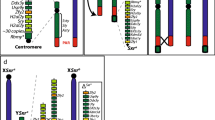Abstract
Recombination in the proximal region of mouse chromosome 17 is greatly reduced in heterozygotes carrying the wild-type and thet complex-type chromosomes. The reason for this is the presence of two non-overlapping inversions in thet complex. Rare crossing-over does, however, occur within thet complex of thet/+ heterozygotes. Here we characterize four such exceptional intra-t recombinants,t Tu1 throught Tu4. To map the positions of the genetic exchange in these four recombinants, we analyzed them with DNA probes specific for 16 loci distributed over thet complex. The analysis revealed that in three of the four recombinants, an equal crossing-over occurred in the short region between the two inversions, producing chromosomes carrying either the proximal inversion only (t Tu1 andt Tu4) or the distal inversion only (t Tu2). In the fourth recombinant (t Tu3), unequal crossing-over occurred within the proximal inversion between lociD17Leh119 andD17Leh66, producing a chromosome in which the region containing lociTcp-1, T, andD17Tu5 has been duplicated. The duplication of theBrachyury locus leads to the suppression of the tail-shortening effect normally produced by the interaction of the dominant (T) and recessive (tct) alleles at this locus so that theT/t Tu3 mice have normal tails.
Similar content being viewed by others
References
Artzt, K., Shin, H.-S., and Bennett, D.: Gene mapping within theT/t complex of the mouse. II. Anomalous position of theH-2 complex int haplotypes.Cell 28: 471–476, 1982
Bennett, D.: The T-locus of the mouse.Cell 6: 441–454, 1975
Bennett, D., Dunn, L. C., and Artzt, K.: Genetic changes in mutants at theT/t-locus in the mouse.Genetics 83: 361–372, 1976
Bućan, M., Herrmann, B. G., Frischauf, A.-M., Bautch, V. L., Bode, V., Silver, L. M., Martin, G. R., and Lehrach, H.: Deletion and duplication of DNA sequence is associated with the embryonic lethal phenotype of the t9 complementation group of the mouset complex.Genes and Development 1: 376–395, 1987
Figueroa, F., Golubić, M., Nižetić, D., and Klein, J.: Evolution of mouse major histocompatibility complex genes borne byt chromosomes.Proc Natl Acad Sci USA 82: 2819–2823, 1985
Fox, H., Silver, L. M., and Martin, G. R.: An alpha globin pseudogene is located within the mouset complex.Immunogenetics 19: 125–130, 1984
Fox, H. S., Martin, G. R., Lyon, M. F., Herrmann, B., Frischauf, A. M., Lehrach, H., and Silver, L. M.: Molecular probes define different regions of the mouset complex.Cell 40: 63–69, 1985
Herrmann, B., Bućan, M., Mains, P. E., Frischauf, A.-M., Silver, L. M., and Lehrach, H.: Genetic analysis of the proximal portion of the mouset complex: evidence for a second inversion withint haplotypes.Cell 44: 469–476, 1986
Herrmann, B. G., Barlow, D. P., and Lehrach, H.: A large inverted duplication allows homologous recombination between chromosomes heterozygous for the proximal t complex inversion.Cell 48: 813–825, 1987
Kasahara, M., Figueroa, F., and Klein, J.: Random cloning of genes from mouse chromosome 17.Proc Natl Acad Sci USA 84: 3325–3328, 1987
Klein, J.:Natural History of the Major Histocompatibility Complex, Wiley-Interscience, New York, 1986
Klein, J., Sipos, P., and Figueroa, F.: Polymorphism oft complex genes in European wild mice.Genet Res 44: 39–46, 1984
Leder, A., Swan, D., Ruddle, F., d'Eustachio, P., and Leder, P.: Dispersion of α-like globin genes of the mouse to three different chromosomes.Nature 293: 196–200, 1981
Lyon, M. F.: Transmission ratio distortion in mouset-haplotypes is due to multiple distorter genes acting on a responder locus.Cell 37: 621–628, 1984
Lyon, M. F.: Male sterility of the mouset-complex is due to homozygosity of the distorter genes.Cell 44: 357–363, 1986
Lyon, M., and Meredith, R.: Investigations of the nature oft-alleles in the mouse. I. Genetic analysis of a series of mutants derived from a lethal allele.Heredity 19: 301–312, 1964a
Lyon, M., and Meredith, R.: Investigations of the nature oft-alleles in the mouse. II. Genetic analysis of an unusual mutant allele and its derivatives.Heredity 19: 313–325, 1964b
Lyon, M. and Meredith, R.: Investigatons of the nature oft-alleles in the mouse. III. Short tests of some further mutant alleles.Heredity 19: 327–330, 1964c
Mizuno, K., Vincek, V., Figueroa, F., and Klein, J.: TheD17Tu5 locus in thet complex: implications for the origin oft haplotypes and inbred strains.Immunogenetics 30: 105–111, 1989
Sarvetnick, N., Fox, H. S., Mann, E., Mains, P. E., Elliott, R. W., and Silver, L. M.: Nonhomologous pairing in mice heterozygous for at haplotype can produce recombinant chromosomes with duplications and deletions.Genetics 113: 723–734, 1986
Schimenti, J., Vold, L., Socolow, D., and Silver, L. M.: An unstable family of large DNA elements in the center of the mouset complex.J Mol Biol 194: 583–594, 1987
Silver, L. M.: Mouset haplotypes.Annu Rev Genet 16: 164–180, 1985
Silver, L. M. and Riems, D.: Five to nine genetically defined regions of mouset haplotypes are involved in transmission ratio distortion.Genet Res 49: 51–56, 1987
Styrna, J. and Klein, J.: Evidence for two regions in the mouset complex controlling transmission ratios.Genet Res 38: 315–325, 1981
Vojtíišková, M., Viklický, V., Voráčová, B., Lewis, S. E., and Gluecksohn-Waelsch, S.: The effects of at allele (t AE5) in the mouse on the lymphoid system and reproduction.J Embryol Exp Morphol 36: 443–451, 1976
Willison, K. R., Dudley, K., and Potter, J.: Molecular cloning and sequence analysis of a haploid expressed gene encodingt complex polypeptide 1.Cell 44: 727–738, 1986
Winking, H. and Silver, L. M.: Characterization of a recombinant mouseT haplotype that expresses a dominant lethal maternal effect.Genetics 108: 1013–1020, 1984
Author information
Authors and Affiliations
Rights and permissions
About this article
Cite this article
Mizuno, K., Vincek, V., Figueroa, F. et al. Molecular characterization of four intra-t mouse recombinants. Immunogenetics 30, 112–118 (1989). https://doi.org/10.1007/BF02421539
Received:
Issue Date:
DOI: https://doi.org/10.1007/BF02421539




